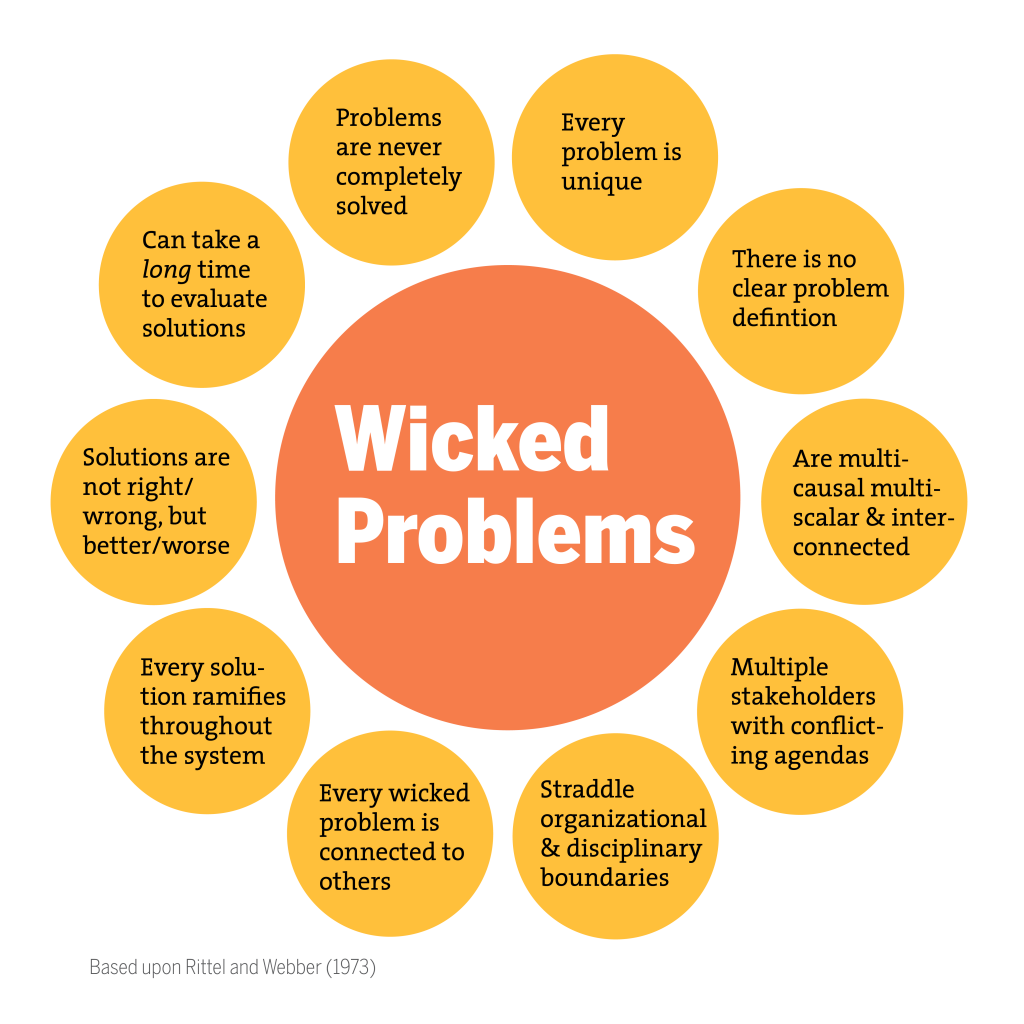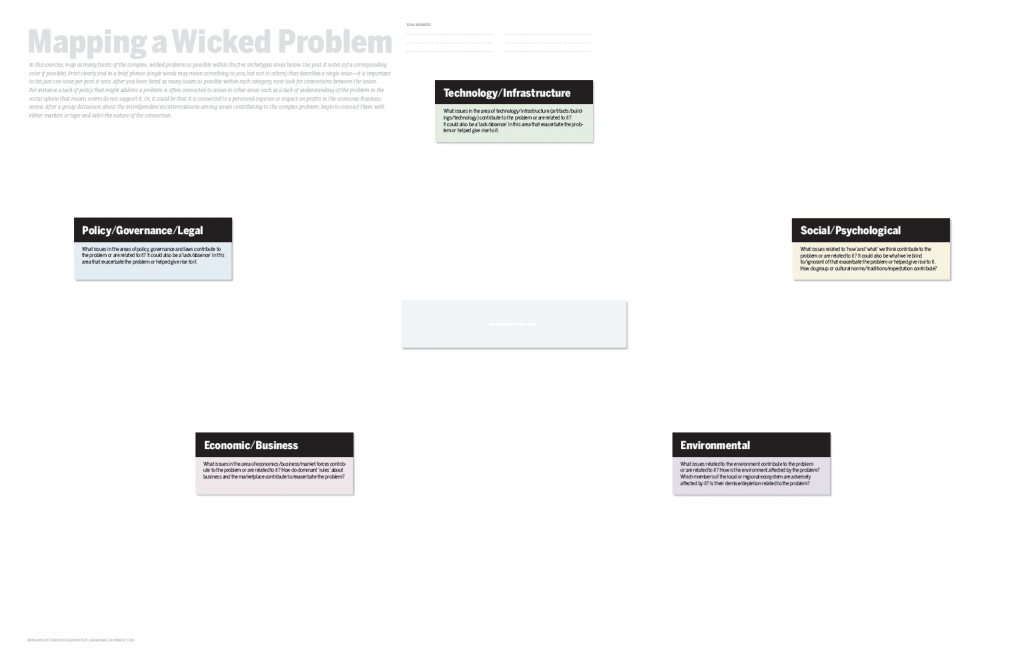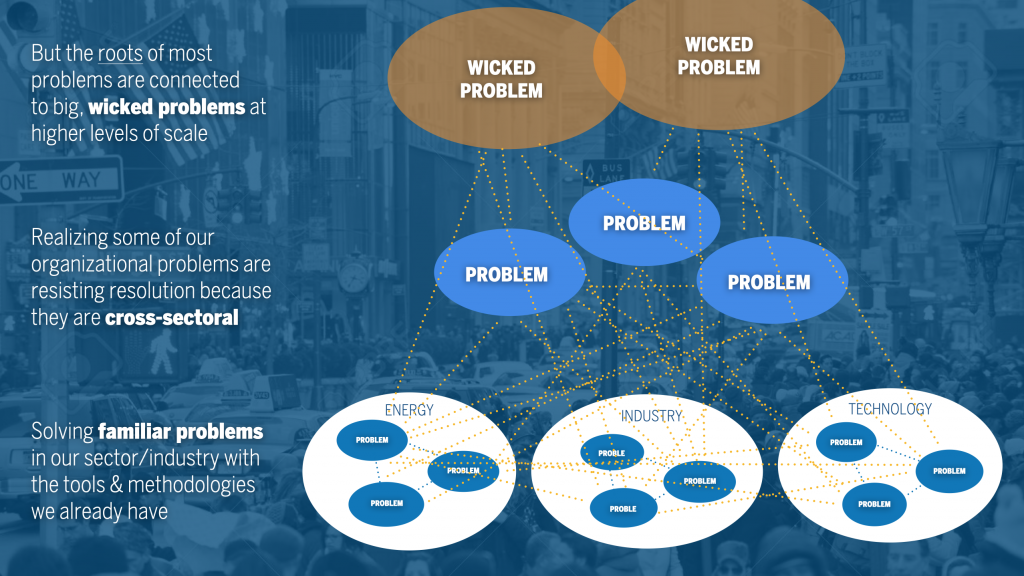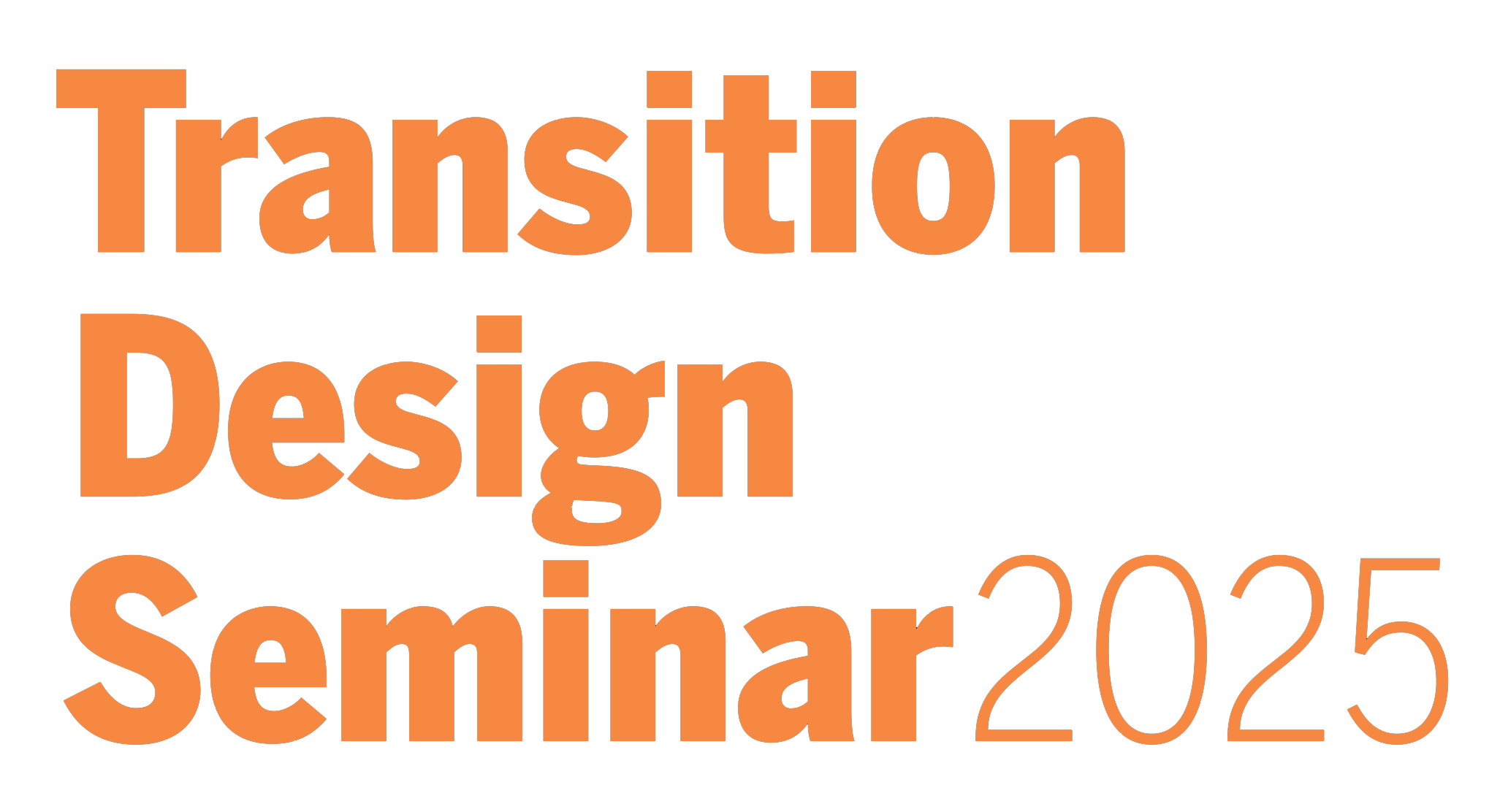In the latter half of the 20th century, design theorists Horst Rittel and Melvin Webber coined the term “wicked problem” to describe a class of problems they deemed “unsolvable” because of their high degrees of complexity. They contrasted these with “tame” problems that could be solved using traditional processes, based upon predicted outcomes. At the same time, discoveries in the emerging field of chaos and complexity sciences were shedding light on both the structure and behavior of complex, open systems. Principles such as emergent properties, self-organization, and sensitivity to initial conditions, are crucial in understanding and addressing (intervening in systems) wicked problems and shifting transition trajectories.
Lecture & Discussion – 1.15.2025
Wicked Problems: Anatomy & Dynamics + Assignment #1

Traditional problem-solving approaches are characterized by de-contextualized problem frames and linear, cause/effect processes, whose objective is the swift realization of predictable and profitable solutions. In contrast, the Transition Design approach calls for the development of new tools to ‘map’ the dynamics within wicked problems and their larger systems contexts in order to understand and leverage them them in the formulation of systems interventions (solutions) aimed at their resolution:
Wicked problems are multi-scalar, multi-causal, and interdependent: problems such as crime, political and social polarization, forced migration, poverty, homelessness, climate change and many others, manifest at multiple level of scale (neighborhoods, districts, the city and even the region), and have multiple root causes because they are linked to other wicked problems. For example, homelessness in many cities can be directly linked to other wicked problems such as the financial crisis of 2008, opioid addiction, gentrification, racial profiling, and a lack of access to affordable education. Issues such as racial profiling can arise from within the city and its neighborhoods, but others like the financial crisis or the national opioid epidemic originate at the national or global level, then cascade down systems levels. These multiscalar dynamics, which unfold over short, mid and long horizons of time add exponentially to a wicked problems’ level of complexity.
Wicked problems have self-organizing features, display emergent properties and are permeated by complex, social dynamics: Wicked problems are ‘tangles’ of designed artifacts, communications, built infrastructure, technology, scripted interactions and most importantly—people—which makes both their structure and behavior highly complex. Chaos and complexity theories show that social systems are highly self-organizing, and their response to perturbations and disruptions from their external environment (events, innovations, new technologies, practices, cultural norms etc.) is highly self-directed and unpredictable. When perturbed, these systems respond in ways that often give rise to new, unexpected and “emergent” forms of behavior.
To extend the example of homelessness within a city, an external perturbation to a homeless population might take the form of police evicting homeless people from parks and other public spaces. In cities like San Francisco, a perturbation like this has resulted in homeless populations self-organizing to form “emergent” settlements in gentrified neighborhoods or along public thoroughfares and streets, which has given rise to a host of new problems related to public health and safety, but in another country or city, the response might be completely different.
Wicked problems are comprised of multiple stakeholders with conflicting agendas and concerns: Wicked problems are connected to and adversely affect countless stakeholder groups that are human and non-human. Stakeholder groups often lack a shared understanding of the problem and have conflicting ideas about how to solve it. This can be due to differences in socio-economic-political status (uneven power dynamics and access to resources) as well as differing beliefs, values, assumptions, expectations and needs. More about the ways in which stakeholder relations form a type of ‘connective tissue’ within wicked problems, can be found in the following section: Mapping Stakeholder Relations.
Wicked problems are governed by positive and negative feedback loops: Transition Design argues that understanding these dynamics within complex systems (wicked problems and their systems contexts), is critical to resolving wicked problems. Positive feedback loops enhance or amplify changes and can have a destabilizing effect on the system, while negative feedback loops tend to dampen or buffer changes, making present conditions more stable. Positive feedback is present when a small change or intervention in the system rapidly amplifies. The effects of feedback can be growth, chaotic behavior, disequilibrium and overall system instability. Positive feedback loops often create or exacerbate wicked problems. Negative feedback loops are more difficult to identify and are often barriers to wicked problem resolution. Initiatives aimed at resolving a wicked problem may be implemented but are ineffective because something (negative feedback) prevents the positive change from taking hold. A negative feedback loop often involves something unseen, such as attitudes, beliefs, values, behaviors and practices which can represent entrenched ways of thinking and acting.
Wicked problems straddle institutional, disciplinary and sectoral boundaries: Wicked problems manifest at multiple levels of scale (from the global level to that of our everyday lives), connect to myriad other wicked problems, and straddle institutional, disciplinary and even sectoral boundaries. However, traditional problem-solving approaches tend to frame and address problems entirely within disciplinary silos and/or domains of expertise. This approach is evident in most of our societal organization and infrastructure such as: “transport”, “economic development”, “health and public safety”, “energy”, “housing”, “education”, etc. Within a silos teams of experts from specific and often narrow domains of expertise to develop highly specialized, targeted solutions. The solutions that arise out of these “single-solution-to-a- single-problem” approaches rarely resolve a wicked problem because they are often addressing a ‘symptom’ of a bigger, higher level problem. Transition Design argues that much larger problem frames (that span disciplinary and sectoral divides) and radical, transdisciplinary collaboration are fundamental in effectively addressing wicked problems.
Mapping Wicked Problems
Winston Churchill famously argued that we shape our tools, and they in turn, shape us. Transition Design argues that one of the reasons traditional problems-solving approaches fall short is due to their linear, predictive, cause-and-effect approach. Since wicked problems are systems problems, more holistic and systemic approaches to addressing them are needed. Among the most urgently needed, are tools for mapping wicked problems and their internal dynamics. A comprehensive problem map can identify ‘leverage points for intervention’ in the system that have the potential to ignite positive, systems-level change and shift the larger system’s transition trajectory.
The principle is similar to Chinese acupuncture in which needles (interventions) placed at strategic points in the system (the human body) ‘perturb’ it to respond in ways intended to bring it back into balance over time (individual systems transition). Acupuncturists place the needles by referring to a comprehensive systems map of the body’s meridians (developed more than 3000 years ago).Transition Design contends that in order to solve a complex, systems problem, we need a comprehensive map of the system that show us where to intervene, that functions as a type of meridian map of the wicked problem and its larger context (the socio-technical-ecological system).
Although there are many digital mind mapping tools available as well as software for visualizing complex datasets, we still lack appropriate tools for mapping systems from multiple Digital tools for mapping systems ‘organically’ and flexibly in ways that reflect of changing and deepening understanding of them and that integrates multiple stakeholder perspectives is urgently needed. Currently, our ability to solve systems problems is impeded by a lack of appropriate tools. Nevertheless, the Transition Design approach works with the tools available to map complex wicked problems and their countless interrelated and interdependent issues within 5 archetypal areas:
1) infrastructural/science/technology issues; 2) political/legal issues; 3) social; 4) business/ economic; 5) environmental. And, these systems problems are permeated by social and cultural norms, practices, beliefs, assumptions, behaviours, rules and ‘ways of doing things.’
In the Transition Design seminar, collaborative teams ‘map’ a wicked problem in the categories above and map their interconnections and interdependencies among issues. Because of the short duration of the semester-long class, this work is hypothetical and based upon internet-based research. On an actual project, the map would be based upon a variety of qualitative research methods to collect both stakeholder and relevant expert perspectives with which to build the map. This process would likely take place over many months and would become an ongoing, iterative process, connected to the other 4 steps in the approach (assignments 2-5). Students in the 2021 seminar should read a detailed description of Assignment #1 below and in the Assignments section of this website.
Discussion Prompts
- Why are wicked problems also referred to as systems problems??
- What is an example of a seemingly ‘simple’ problem you encounter at home/work that is actually a ‘symptom’ of a larger, wicked problem? How does remaining blind to these connections between systems-levels impede our ability to solve problems??
- Can you think of ways in which the inherent dynamics within complex systems (such as feedback loops) exacerbate wicked problems?
- What do we mean by the phrase “a wicked problem or complex system can be ‘perturbed’ by the outside world, but its response to that perturbation is internally directed/determined? Why is this relevant to our ability to solve for complex problems??
- What are the implications of systems principles such as self-organization and emergence to wicked problems?
- Is it possible to understand and visualize the entirety of a wicked problem? If not, then why should we try?
- What are examples of global wicked problems that are interrelated and interdependent?
- How would you characterize or distinguish between the consequences of a wicked problem and the root cause? Why is it important to make a distinction?
Required Readings
- Kossoff, Gideon and Irwin, Terry. 2022. Transition Design as a Strategy for Addressing Urban Wicked Problems. In Cities After Capitalism, Routledge. pp.90-102
- Capra, Fritjof and Pier Luigi Luisi. 2014. Connecting the Dots. In The Systems View of Life. Cambridge University Press, Cambridge, pp. 362-366*
Supplemental Readings
- Australian Public Service Commission. 2007. Tackling Wicked Problems: A Public Policy Perspective. In Contemporary Government Challenges. Canberra, Australian Public Service Commission. pp. 1-4; Chap. 4, 6, 8, 10, 11
- Irwin, Terry. 2013. Living Systems Principles and Their Relevance to Design. Academia.edu https://terryirwin.academia.edu/research#papers
- Irwin, Terry. 2011. Wicked Problems and the Relationship Triad. In Stephan Harding (ed.), Grow Small, Think Beautiful: Ideas for a Sustainable World from Schumacher College. Edinburgh: Floris Books. pp 232–257. Academia.edu https://terryirwin.academia.edu/research#papers
- Buchanan, Richard. 1992. Wicked Problems in Design Thinking. In Design Issues 8(2): 5–21*
- Coyne, Richard. 2005. Wicked Problems Revisited. In Design Studies 26: 5–17*
Assignments #1: Mapping a Wicked Problems
Assignment #1: In this assignment, teams will map their wicked problem in the five categories above using the template in their Miro team board. Instructions for Assignment #1 can be found in the assignment section of this website. This assignment is due by end of day on February 2nd as: 1) both a high-resolution PDF (exported from Miro) uploaded to their team folder in Box; 2) as a Medium post in which the assignment is analyzed and insights drawn out (with high-resolution images illustrating the article).
NOTE: the templates below are included as an analog resource for outside educators using this site. Students in this seminar should use the Miro templates.

Lecture & Discussion – 1.22.2025
Wicked Problems & Globalization
Transition Design argues that many wicked problems are global in scope: climate change, poverty, income inequality, lack of access to clean water, affordable education and housing, systemic racism, forced migration and countless others. Because these problems are ubiquitous, they can sometimes seem remote and abstract within the context of our everyday lives. However, these problems manifest in ways that are distinct to place, culture and ecosystem. And, often the seemingly ‘simple’ problems we confront that remain resistant to resolution are actually symptoms of wicked problems at higher levels of scale.

In this class, we explore wicked problems in relation to globalization and the myriad issues connected to it. Globalization is a term used to describe the growing interdependence of global governments, economies, cultures, and populations in order to exchange goods, services, technology and flows of investment and information. Implicit within the concept of globalization is that ongoing, unbridled economic growth is possible and desirable. Neoliberalism is the body of ideas and beliefs that underlie globalization (considered among most economists, politicians and the media) to be necessary for the maximization of economic growth. Implicit within neoliberalism are the ideas that deregulation of the market and privatization of the public sector are the most effective ways of generating economic growth and raising living standards. It is worth noting that a 1972 report entitled The Limits to Growth identified the exponential economic and population growth on a planet with a finite supply of resources as one of the biggest challenges facing 20th century societies. The video at the bottom of this page illustrates the difference between growth and development.
Wicked Problems Connected to Globalization
Since the late 1970s/early 1980s, globalization and neoliberalism have led to the development of a global marketplace in which national economies are increasingly interdependent and integrated; in which the responsibility for local and national government to ensure the well-being of their citizens has been greatly diminished; and in which many collectively owned assets and services have been privatized and absorbed into the market. Both globalization and neoliberalism have had a dramatic and often adverse influence on the ways in which much of the world’s population live their lives and meets their needs. Because of this, globalization is at the root of, or has exacerbated, many wicked problems such as the ones listed below. Because mainstream economics focuses on the monetary/for-profit growth of the economy, it usually views the adverse consequences of globalization as ‘externalities’ and therefore excludes them from consideration.
Globally unregulated economic growth: in which the expansion of Gross Domestic Product (GDP) and the size of shareholder dividends are the primary criteria of success — has frequently damaged or destroyed the social and ecological fabric at local, regional and planetary scales.
Inequity and poverty: globalisation has concentrated financial power in the hands of a tiny minority giving rise to enormous disparities in wealth and opportunities within countries, between countries and between hemispheres, leaving much of the world’s population impoverished and economically insecure.
Forced migration: appropriation of natural resources, ecological degradation, fossil fuel driven climate change and other upheavals at the regional level that are caused or exacerbated by the ever expanding global production/consumer demand, often leads to the displacement of large populations.
Loss of biodiversity/ecological degradation: expansion of systems of production, commerce and transport on a global scale are causing or exacerbating air, land and water pollution, loss of topsoil and deforestation (to name a few) leading to an unprecedented decline in biodiversity and undermining the viability of many of the natural systems on which we, and other beings, depend.
Resource wars: an expanding, globalized and interdependent economy, that serves an increasingly consumerist society, leads to the appropriation by multinational entities of land, resources and materials, and has contributed to civil and international conflict and human rights violations
Loss of indigenous and local cultures: because globalization centralizes control of systems of production, consumption and distribution, and promotes Western norms, it homogenizes lifestyles, contributing to the demise of many traditional local cultures and practices, and to the loss of the indigenous and place/ecosystem based ways of life that these embodied.
Decline of communities and local economies: globalization leads to the fragmentation and hollowing out of local economies, and the urban and rural communities they support, as multinational corporations move operations around the planet in order to increase profit margins and as they make it increasingly difficult for locally owned business to thrive,
Adverse health effects: Since globalization comprises social, physical, cultural, economic and ecological systems (which are the foundation for individual wellbeing) all of the above problems are implicated in the spread of many mental and physical health disorders.
Policy makers and the media argue that “There is No Alternative” (known as the ‘TINA’ argument) to globalization, but this has been challenged in myriad ways by grassroots activists, writers, academics, NGOS, and green political parties and think tanks. Alternative approaches to economics emphasize the importance of non-material as well as material needs, and argue for the re-contextualization of the market (the economic system) in social and natural ecosystems. They argue for the development of decentralized and locally networked economic systems which allow for local and regional self-management. An understanding of the wicked problems caused by globalization and familiarity with alternative approaches to economics is vital to transition designers as they facilitate and choreograph interventions at all levels of scale to address all kinds of wicked problems.
Discussion Prompts
- This critique of globalization is highly controversial. Do you agree with it, and if not, why not?
- What are two to three wicked problems related to globalization that affect you in your everyday life?
- Do you agree with the proposed alternatives to globalization, and if not why not?
- Globalization defines wealth in terms of monetary measures, discuss what an alternative definition of wealth might be.
- If growth is the indicator for economic health what would the indicator(s) be for an alternative economic system?
- Globalization attempts to apply a one-size fits all in terms of health and well being? Is this problematic, and if so why and what would an alternative be?
- Globalization is based on centralized structures and organizations such as the WTO and IMF. In what ways are these problematic and if so what would alternatives look like?
- Why is it problematic to apply metrics from the Western developed world to other cultures and societies to assess their well-being?
- Discuss the ways in which globalization affects your own lifestyle and everyday life, in both positive and negative ways.
- Discuss the ways in which designers and design practice are inextricably linked with globalization.
- Discuss the implications of globalization for different levels of societal systems, local, regional, national and international.
Required Readings (choose one)
- Mander, Jerry. 2012. Endless Growth on a Finite Planet. In The Capitalism Papers: Fatal Flaws of an Obsolete System. Berkeley, CA, Counterpoint. pp. 81-104.*
- Norberg Hodge, Helena. 2016. The Lose-Lose Economy & From Global to Local. In Localization: Essential Steps to an Economics of Happiness. Local Futures/ISEC, Totnes. pp. vi-viii & pp. 9-33
Supplemental Readings
- Shiva, Vandana. 2015. Living Economies. In Earth Democracy. South End Press, Cambridge, MA. pp. 13–49
- Shiva, Vandana. 2019. Development — For the 1%. In Kothari, Ashish et al (eds.) Pluriverse: A Post-Development Dictionary. New Delhi. pp.6-8
- Smith, Philip B.; Max-Neef, Manfred. 2011. The World on a Collision Course and the Need for a New Economics. In Economics Unmasked: From Power and Greed to Compassion and the Common Good. Dartington, Devon, Green Books. pp. 128-138.*
- Korten, D.1996. The Mythic Victory of Market Capitalism. In The Case Against the Global Economy, Mander, J. and Goldsmith, E. (eds). San Francisco, CA, Sierra Club Books. pp. 183-191.*
- Halstead, T. and Cobb, C. 1996. The Need for New Measurements of Progress. In the Case Against the Global Economy, Mander, J. and Goldsmith E. (eds). San Francisco, CA, Sierra Club Books, pp. 197-206*
- Morris, D.1996. Free Trade: The Great Destroyer. In the Case Against the Global Economy, Mander, J. and Goldsmith E. (eds). San Francisco, CA, Sierra Club Books, pp. 218-228*
The video above illustrates the consequences of unbridled growth on a finite planet
Lecture & Discussion – 1.27.2025
Working Session for Assignment #1
During this class, teams should work in Miro/Zoom on Assignment #1 during class time. Instructors will be present and meet with teams in their breakout rooms. Attendance will be taken for this class.
